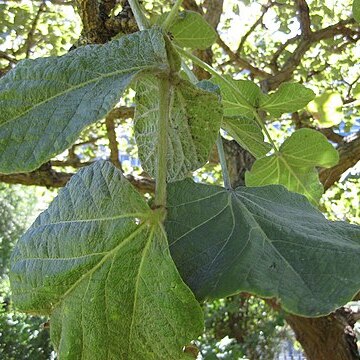Tree, 5-8 m high; branching high above base, crown rounded. Bark dark grey, thick, corky with deep fissures. Branches tomentose when young, becoming glabrous with age, armed with prickles. Leaves pinnately trifoliolate, terminal leaflet remote from the laterals; deciduous; leaflet armed with prickles, tomentose on both surfaces when young. Flowers horizontal, gaping at anthesis, borne in verticils of three and appearing before leaves. Calyx red; tube sheath-like, tomentose, splitting abaxially at anthesis. Petals: standard scarlet to crimson; wings exceeding keel; keel free. Stamens diadelphous. Flowering time late winter to spring. Pod ligneous, sickle-shaped, constricted between seeds, tomentose when young. Seeds crimson; hilum oval, prominent, blackish.
Leaflets with scattered prickles along nerves; terminal leaflet deltate to oblate, often broader than long, 7–25 × 6–30 cm; laterals 6–22 × 7–22 cm, broadly ovate to deltate, the base often somewhat asymmetric; petiole 12–30 cm long, glabrous when mature, rarely with one or two prickles; rhachis 6–15 cm long, tomentose when young becoming glabrous; petiolules 4–20 mm long, tomentose; stipules 6–8 × 4–5 mm, ovate; stipels minute.
Inflorescence a terminal pseudoraceme produced before or with young leaves; peduncle 15–24(30) cm long, densely pale tomentose; rhachis 4.5–9 cm long, with the flowers in fascicles; bracts 1.2–2 cm long, linear-obovate, densely white tomentose, membranous; pedicels 7–9 mm long, villous; bracteoles 1.4–2 cm long, linear, villous.
Corolla scarlet save white margins of wings, glabrous; standard 4.5–5.5 × 2.8–3.3 cm, oblong-elliptic, reflexed back to expose the stamens; wings 2.2–2.5 × 1–1.2 cm; keel petals free, 1.7–2 × 1.3–1.5 cm.
Tree 3–8(10) m tall; bark dark grey, corky with deep longitudinal and transverse fissures; stems and branches armed with scattered large conical spines up to 1 cm long.
Calyx spathaceous, 5-lobed, split fully abaxially by the emergent corolla; tube 1.3–3 cm long; lobes 7–18 mm long, narrowly-cylindrical to filiform.
Vexillary stamen fused along a quarter of its length, others fused into a tube along one-third to half their length.
Pod 18–25 × 2–3 cm, falcate, moniliform becoming glabrous at maturity, (1)3–4(6)-seeded.
Seeds red, reniform, 11–15 × 9–10 × 6–7 mm; hilum black, 7–8 mm long, broadly elliptic.
Ovary 1.5–2 cm long, narrowly cylindrical-filiform.


